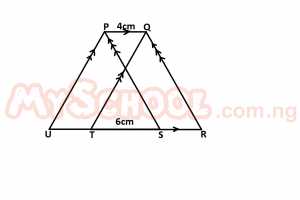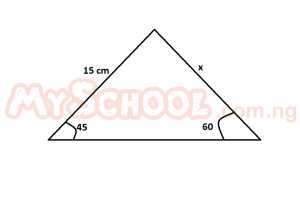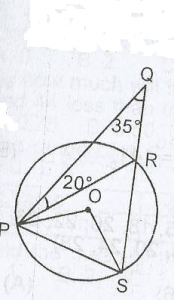Year :
2004
Title :
Mathematics (Core)
Exam :
JAMB Exam
Paper 1 | Objectives
1 - 10 of 45 Questions
| # | Question | Ans |
|---|---|---|
| 1. |
An arc of a circle of length 22 cm subtends an angle of 3x° at the center of the circle. Find the value of x if the diameter of the circle is 14 cm A. 60o B. 120o C. 180o D. 30o Detailed Solution\( ARC\hspace{1mm}length = (\frac{\theta}{360})\times 2\pi r\\22=\frac{3x}{360}\times \left(2 \times(\frac{22}{7})\times(\frac{7}{1})\right)\\3x = 180\\x = \frac{180}{3}\\x = 60^{\circ}\) |
|
| 2. |
Find the value of α2 + β2 if α + β = 2 and the distance between points (1, α) and (β, 1)is 3 units A. 14 B. 3 C. 5 D. 11 Detailed Solution\(PQ = \sqrt{(β - 1)^{2} + (1 - α)^{2}}\\3 =\sqrt{(β^{2} -2β^{2} + 1 + 1 - 2α + α^{2})}\\ 3 = \sqrt{(α^{2} + β^{2} - 2α + 2β + 2)}\\ 3 = \sqrt{(α^{2} + β^{2} - 2(α + β) + 2)}\\ 3 = \sqrt{(α^{2} + β^{2} - 2 * 2 + 2)}\\ 3 = \sqrt{(α^{2} + β^{2} - 2)}\\ 9 = (α^{2} + β^{2} - 2)\\ α^{2} + β^{2} = 9 + 2\\ α^{2} + β^{2} = 11\) |
|
| 3. |
The sum of the interior angles of a pentagon is 6x + 6y. Find y in the terms of x A. y = 90 - x B. y = 150 - x C. y = 60 - x D. y = 120 -x Detailed Solution6x + 6y = (n - 2) 1806x + 6y= (5 - 2) 180 6(x + y) = 3 * 180 x + y = (3 * 180)/6 x + y = 90o y = 90 - x |
|
| 4. |
 In the diagram above, PQ = 4 cm and TS = 6 cm. If the area of parallelogram PQTU is 32 cm\(^2\), find the area of the trapezium PQRU A. 60 cm2 B. 72 cm2 C. 48 cm2 D. 24 cm2 Detailed SolutionArea of parallelogram PQTU = base * height32 = 4 * h w = 32/4 w = 8 ∴ = Area of Trapezium PQRU = (1/2)(4 + 14) *8 = 1/2 * (18 * 8) = 72 cm\(^2\) |
|
| 5. |
Find the midpoint of the line joining P(-3, 5) and Q(5, -3). A. (1, 1) B. (2, 2) C. (4, 4) D. (4, -4) Detailed Solution\(Mid point = \frac{(x_1 + x_2)}{2} ; \frac{(y_1 + y_2)}{2}\\= \frac{(-3 + 5)}{2} ; \frac{(5 - 3)}{2}\\ = \frac{2}{2} ; \frac{2}{2}\\ = (1, 1)\) |
|
| 6. |
Determine the locus of a point inside a square PQRS which is eqidistant from PQ and QR A. The diagonal QS B. the perpendicular bisector of PQ C. The diagonal PR D. side SR Detailed SolutionThe diagonal QS bisects the angle formed by PQ and QR∴ [A] |
|
| 7. |
 Find the value of x in the figure above A. 15√6 B. 20√6 C. 3√6 D. 5√6 Detailed Solution\(\frac{X}{sin45}=\frac{15}{sin60}\\X=\frac{15sin45}{sin60}\\X=\frac{15\times(\frac{1}{\sqrt{2}})}{\sqrt{\frac{3}{2}}}\\X=\frac{15}{\sqrt{2}}\times\frac{2}{\sqrt{3}}\\X=\frac{30}{\sqrt{6}}\\X=\frac{30}{\sqrt{6}}\times\frac{\sqrt{6}}{\sqrt{6}}=\frac{30\sqrt{6}}{6}=5\sqrt{6}\) |
|
| 8. |
 P, R and S lie on a circle center as shown above while Q lies outside the circle. Find ∠PSO A. 45o B. 55o C. 35o D. 40o Detailed Solutionxo = 35 + 29 (Exterior angle = sum of two interior opposite angles)x = 55o (∠ at the center twice ∠ at circumference) y = 110o ∠PSO = ∠SPO (base ∠S of 1sc Δ b/c PO = SO) ∴ ∠PSO = (180 - 110)/2 = 35o |
|
| 9. |
The locus of a point which is 5 cm from the line LM is a A. line distance 10 cm from LM and parallel to LM B. pair of line on opposite sides of LM and parallel to it, each distance 5 cm from LM C. line parallel to LM and 5 cm from LM D. pair of parallel lines on one side of LM and parallel to LM Detailed SolutionThe locus of a point which is 5cm from the line LM is a pair of lines on opposite sides of LM and parallel to it, each distance 5cm from LM. |
|
| 10. |
If y = 3 cos(x/3), find dy/dx when x = (3π/2) A. 1 B. -3 C. 2 D. -1 Detailed Solutiony = 3cos(x/3)dy/dx = 3x(1/3)x - sin (x/3) = - sin x/3 But x = 3π/2 ∴ -sin(x/3) = -sin(3π/6) = -sin (3 * 180)/6 = - sin 90 = -1 |
| 1. |
An arc of a circle of length 22 cm subtends an angle of 3x° at the center of the circle. Find the value of x if the diameter of the circle is 14 cm A. 60o B. 120o C. 180o D. 30o Detailed Solution\( ARC\hspace{1mm}length = (\frac{\theta}{360})\times 2\pi r\\22=\frac{3x}{360}\times \left(2 \times(\frac{22}{7})\times(\frac{7}{1})\right)\\3x = 180\\x = \frac{180}{3}\\x = 60^{\circ}\) |
|
| 2. |
Find the value of α2 + β2 if α + β = 2 and the distance between points (1, α) and (β, 1)is 3 units A. 14 B. 3 C. 5 D. 11 Detailed Solution\(PQ = \sqrt{(β - 1)^{2} + (1 - α)^{2}}\\3 =\sqrt{(β^{2} -2β^{2} + 1 + 1 - 2α + α^{2})}\\ 3 = \sqrt{(α^{2} + β^{2} - 2α + 2β + 2)}\\ 3 = \sqrt{(α^{2} + β^{2} - 2(α + β) + 2)}\\ 3 = \sqrt{(α^{2} + β^{2} - 2 * 2 + 2)}\\ 3 = \sqrt{(α^{2} + β^{2} - 2)}\\ 9 = (α^{2} + β^{2} - 2)\\ α^{2} + β^{2} = 9 + 2\\ α^{2} + β^{2} = 11\) |
|
| 3. |
The sum of the interior angles of a pentagon is 6x + 6y. Find y in the terms of x A. y = 90 - x B. y = 150 - x C. y = 60 - x D. y = 120 -x Detailed Solution6x + 6y = (n - 2) 1806x + 6y= (5 - 2) 180 6(x + y) = 3 * 180 x + y = (3 * 180)/6 x + y = 90o y = 90 - x |
|
| 4. |
 In the diagram above, PQ = 4 cm and TS = 6 cm. If the area of parallelogram PQTU is 32 cm\(^2\), find the area of the trapezium PQRU A. 60 cm2 B. 72 cm2 C. 48 cm2 D. 24 cm2 Detailed SolutionArea of parallelogram PQTU = base * height32 = 4 * h w = 32/4 w = 8 ∴ = Area of Trapezium PQRU = (1/2)(4 + 14) *8 = 1/2 * (18 * 8) = 72 cm\(^2\) |
|
| 5. |
Find the midpoint of the line joining P(-3, 5) and Q(5, -3). A. (1, 1) B. (2, 2) C. (4, 4) D. (4, -4) Detailed Solution\(Mid point = \frac{(x_1 + x_2)}{2} ; \frac{(y_1 + y_2)}{2}\\= \frac{(-3 + 5)}{2} ; \frac{(5 - 3)}{2}\\ = \frac{2}{2} ; \frac{2}{2}\\ = (1, 1)\) |
| 6. |
Determine the locus of a point inside a square PQRS which is eqidistant from PQ and QR A. The diagonal QS B. the perpendicular bisector of PQ C. The diagonal PR D. side SR Detailed SolutionThe diagonal QS bisects the angle formed by PQ and QR∴ [A] |
|
| 7. |
 Find the value of x in the figure above A. 15√6 B. 20√6 C. 3√6 D. 5√6 Detailed Solution\(\frac{X}{sin45}=\frac{15}{sin60}\\X=\frac{15sin45}{sin60}\\X=\frac{15\times(\frac{1}{\sqrt{2}})}{\sqrt{\frac{3}{2}}}\\X=\frac{15}{\sqrt{2}}\times\frac{2}{\sqrt{3}}\\X=\frac{30}{\sqrt{6}}\\X=\frac{30}{\sqrt{6}}\times\frac{\sqrt{6}}{\sqrt{6}}=\frac{30\sqrt{6}}{6}=5\sqrt{6}\) |
|
| 8. |
 P, R and S lie on a circle center as shown above while Q lies outside the circle. Find ∠PSO A. 45o B. 55o C. 35o D. 40o Detailed Solutionxo = 35 + 29 (Exterior angle = sum of two interior opposite angles)x = 55o (∠ at the center twice ∠ at circumference) y = 110o ∠PSO = ∠SPO (base ∠S of 1sc Δ b/c PO = SO) ∴ ∠PSO = (180 - 110)/2 = 35o |
|
| 9. |
The locus of a point which is 5 cm from the line LM is a A. line distance 10 cm from LM and parallel to LM B. pair of line on opposite sides of LM and parallel to it, each distance 5 cm from LM C. line parallel to LM and 5 cm from LM D. pair of parallel lines on one side of LM and parallel to LM Detailed SolutionThe locus of a point which is 5cm from the line LM is a pair of lines on opposite sides of LM and parallel to it, each distance 5cm from LM. |
|
| 10. |
If y = 3 cos(x/3), find dy/dx when x = (3π/2) A. 1 B. -3 C. 2 D. -1 Detailed Solutiony = 3cos(x/3)dy/dx = 3x(1/3)x - sin (x/3) = - sin x/3 But x = 3π/2 ∴ -sin(x/3) = -sin(3π/6) = -sin (3 * 180)/6 = - sin 90 = -1 |